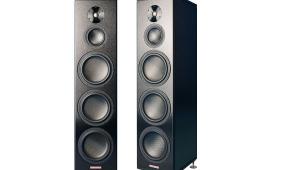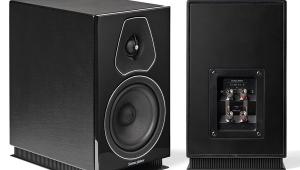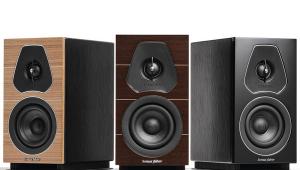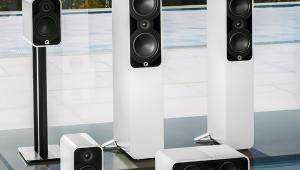Bowers & Wilkins PM1 - £2,000

Although the mainstream marketplace for hi-fi loudspeakers invariably tends to equate price with size and necessarily expects a costly loudspeaker to be a large loudspeaker, more sophisticated hi-fi customers are aware that this relationship is largely false.
It’s certainly true that a small loudspeaker is bound to have certain limitations, especially in areas such as bass extension, loudness capability and power handling. However, such designs also have certain strengths that are often all too easily overlooked, over and beyond the obvious fact that for many customers, when it comes to loudspeakers (rather than, say, TV screens), small is, by definition, beautiful.
For example, the smaller the loudspeaker, the less the enclosure area available to radiate unwanted cabinet colorations. The fact that it has roughly the same dimensions as a human head is bound to assist voice reproduction and wide dispersion assists stereo imaging. And getting the bass/mid driver well off the fl oor with space all around it helps avoid the colorations caused by early reflections.
Matrix stiffeningPriced close to £2,000 per pair, the PM1 is precisely aimed at the established sector of luxury-finish mini-monitors, combining top-quality engineering within a beautifully designed and crafted physical package. With an internal volume of around eight litres, it’s actually somewhat larger than the ‘classic’ miniature, probably because the enclosure is so substantially built, including part-filling the insides with Bowers & Wilkins’ proprietary Matrix stiffening. The thick side panels are finished in a lovely high-gloss ‘Mocha Gloss’ veneer, with heavily chamfered edges that blend nicely into the textured – almost rubberised – matt black front and the domed top, helping avoid edge-diffraction effects. The same textured black covers the other two surfaces, while the domed top provides support for the external tweeter’s tapered metal rear-loading and mounting tube. Two detachable, magnetically held grilles are available: one for the front, the other for the tweeter, although neither was used during the auditioning.
Bowers & Wilkins has packed much of its latest technology into this bijou enclosure. The tweeter is particularly unusual, but the 130mm bass/mid driver uses an interesting new central phase compensator and dust dome. This hemispherical polymer foam ‘plug’, attached to the 90mm Kevlar cone, not only supplies the required acoustic characteristics, but also absorbs and damps resonances.
Two pairs of high-quality multiway terminals permit bi-wiring or bi-amping and wire links are supplied for single wiring. These feed a very simple crossover with high quality components. The front panel has a ‘flowport’– a port fl ared at each end and with a stippled surface to improve high velocity flow. A clever two-piece foam bung is supplied, either to block or re-tune the port if desired.
Super tweeterBecause the diamond diaphragm used in the company’s top models would be too costly for the PM1’s intended price, the tweeter here has a traditional alloy dome. But it does benefi t from an interesting innovation that helps move the performance of the metal dome rather closer to diamond than before.
This is a ring made from pitch-based carbon fi bre threads, which has an exceptionally high Young’s modulus. Applied around the dome’s ‘skirt’, the resultant increase in stiffness moves the diaphragm’s first break-up frequency from 30kHz to 40kHz – still well below the 70kHz found with diamond, but a worthwhile increase nonetheless.The PM1 tweeter has also adopted a couple of techniques developed for the latest diamond tweeters, including a new surround rubber and a simpler, but related neodymium magnet structure.
The PM1 has a partnering stand (codenamed FS-PM1), which looks very attractive, lifts the speaker an appropriate 620mm from the floor, provides a very substantial mechanical foundation and also a means of concealing the cables leading from the speaker terminals to the floor.
At £400 per pair, it’s much more costly than a typical universal stand, but that’s not unusual for a stand dedicated to a particular model and, therefore, produced in relatively small quantities. Furthermore, it’s beautifully designed, presented and finished.
The hefty black lacquer- finished base has a generous stability footprint, while the central pillar, decorated in the same Mocha Gloss veneer used on the speaker, has a couple of deep grooves on the front face to inhibit coherent reflections. Lockable spikes or softer semispherical feet provide floor coupling.
The stand comes, probably inevitably, fl at-packed, so if the dealer can’t be persuaded to carry out the assembly, it’s best to set aside a couple of hours and make sure the electric screwdriver is fully charged (although an appropriate hex key is supplied, each stand uses a dozen bolts, so finding the right bit for the screwdriver is well worthwhile) Assembly is straightforward enough, though a bit tricky and while the diagram is clear enough, a step-bystep guide would help avoid the occasional pitfall. The trickiest part is actually bolting the speaker to the top plate, for the obvious reason that the external tweeter and domed top prevent the speaker being turned upside down to facilitate this.
Unlike stand assembly, it only takes a few minutes to unpack a pair of standmounts, so initial listening was carried out using the Kudos S100 stands that are a regular reference. Blu-tacked to the top plate, the sound was frankly rather disappointing. Despite delivering a decent overall tonal balance when sited well clear of walls, the sound somehow lacked overall coherence and was weak in presence energy.
After a couple of exasperating days, the bullet was bit and the FS-PM1 stands were assembled. The results were mildly astonishing and unquestionably transforming. That the stand plays a significant role in the sound quality of a standmount speaker is pretty well known, but we were still surprised at how considerable and dramatic the difference was on this occasion. Although no longer in production, the Kudos S100 stand is an excellent example of a ‘universal’ stand, but in performance terms it was no match for using the PM1 on its intended stand.
Now the speaker was able to demonstrate its true class as a genuine mini-monitor. It has a beautifully smooth, even and neutral balance, as well as a clean and lively disposition. It also sounds exceptionally coherent and free from any boxiness, with fine spacious imaging, though the presence might have had tighter focus. Measurement confirmed an exceptional +/-2dB in-room averaged balance for all frequencies above 90Hz and +/-3dB above 40Hz.
Bass alignmentOne of its more impressive characteristics was the evenness of the bass alignment and here the modest size of this little speaker proved a positive advantage. Larger standmounts often show a tendency to mid-bass excess, due to the port output coinciding with a bass room mode.
The unobstructed port of the PM1 is actually tuned to 53Hz, bang on a major mode in our listening room, but because the speaker is relatively small this merely means that it delivers decently even bass down to 40Hz, even when its sited well clear of walls. This positioning gives the lowest coloration and the best stereo imaging under our far-field in-room conditions.
While room modes will always boost the in-room bass, their effects are unpredictable and vary from room to room. Blocking the ports completely with the foam bungs should give the best results if the speaker is to be placed close to a wall. Removing the centre section from the bungs will reduce the port output and re-tune it to around 38Hz, a ‘halfway house’ condition that could prove useful depending on individual circumstances.
Music spectrumExtended listening confirmed this speaker’s wonderfully smooth and neutral delivery and its impressive freedom from colorations. All the benefits that a small loudspeaker automatically accrue are clearly evident here, but there’s no avoiding the audibility of the down sides too, although that tends to depend, at least, to some extent on the material being reproduced.
Inevitably the lack of serious bass weight, authority and grip becomes apparent when the speaker is required to reproduce full-bore electric rock or dance material, or large-scale orchestral performances for that matter. However, acoustic sources and vocal material, including speech, were much more convincing, although dynamics themselves do lack a little vigour and enthusiasm, especially through the presence region. Because there’s so little background ‘hash’ to interfere with the resolution of low-level information, the dynamic range is actually very wide.
A long evening spent playing a wide range of vinyl favourites proved highly enjoyable and if the PM1 got a bit out of its depth with live Grateful Dead recordings and more recent material from Massive Attack, its reproduction of Ry Cooder, Joni Mitchell and Tom Waits discs was quite delightful. It even coped manfully with the full-scale broadcast onslaught of the Last Night of the Proms (which did come as a surprise) and it also proved very capable of distinguishing the varying qualities of the different transmission media.
Ultimately, this is a small loudspeaker and, as such, will never match the sheer drama of the very best large loudspeakers across the full spectrum of music. However, its lack of visual intrusiveness, plus the fine imaging and superb neutrality and dynamic range are their own reward.
LIKE: Fine imaging; superb neutrality and dynamic range
DISLIKE: Limited bass weight and authority; some weakness in dynamic expression
WE SAY: A very attractive loudspeaker, but does have some pitfalls
PRODUCT:
Bowers &Wilkins
PM1
ORIGIN: UK
TYPE:
Two-way compact
standmount
WEIGHT: 9.3kg
DIMENSIONS
(WxHxD)
191x331x250mm
FEATURES:
• 25mm alloy dome
tweeter
• 130mm Kevlar cone
bass/mid driver
• Port on front
• Tube-loaded
external and
decoupled tweeter
• Partnering FS-PM1
stand has matching
veneer on pillars
• Optional grille
held by concealed
magnets
• Twin terminal pairs
• Double bungs
provide bass
tuning options
DISTRIBUTOR:
Bowers & Wilkins
TELEPHONE:
01903 221500
WEBSITE:
bowers-wilkins.com
 |
Inside this month's issue:
Q Acoustics 3020c standmount loudspeakers, Perlisten R10s active subwoofer, Quad 33 and 303 pre/power amps, Acoustic Solid Vintage Full Exclusive turntable, newcomer Fell Audio Fell Amp and Fell Disc and lots, lots more...
|













































